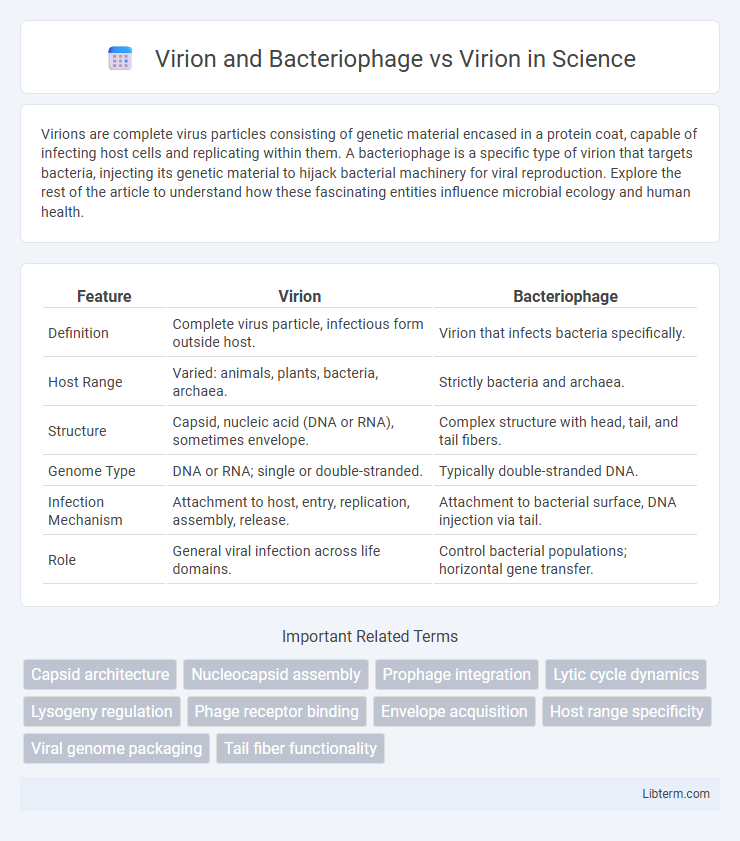Virions are complete virus particles consisting of genetic material encased in a protein coat, capable of infecting host cells and replicating within them. A bacteriophage is a specific type of virion that targets bacteria, injecting its genetic material to hijack bacterial machinery for viral reproduction. Explore the rest of the article to understand how these fascinating entities influence microbial ecology and human health.
Table of Comparison
| Feature | Virion | Bacteriophage |
|---|---|---|
| Definition | Complete virus particle, infectious form outside host. | Virion that infects bacteria specifically. |
| Host Range | Varied: animals, plants, bacteria, archaea. | Strictly bacteria and archaea. |
| Structure | Capsid, nucleic acid (DNA or RNA), sometimes envelope. | Complex structure with head, tail, and tail fibers. |
| Genome Type | DNA or RNA; single or double-stranded. | Typically double-stranded DNA. |
| Infection Mechanism | Attachment to host, entry, replication, assembly, release. | Attachment to bacterial surface, DNA injection via tail. |
| Role | General viral infection across life domains. | Control bacterial populations; horizontal gene transfer. |
Introduction to Virions and Bacteriophages
Virions are complete virus particles consisting of genetic material encased in a protein coat, capable of infecting host cells across various domains of life. Bacteriophages, a specific type of virion, exclusively target bacterial cells and play crucial roles in bacterial population control and horizontal gene transfer. Understanding the structural components and infection mechanisms of both virions and bacteriophages provides key insights into viral replication and host-virus interactions.
Defining Virion: Structure and Function
Virion refers to the complete, infectious form of a virus outside a host cell, consisting of genetic material enclosed in a protein coat called a capsid, sometimes surrounded by a lipid envelope. Bacteriophages, or phages, are specialized virions that infect bacteria, characterized by complex structures including a head, tail, and tail fibers facilitating host attachment and DNA injection. Understanding virion structure and function highlights their role in viral infection transmission and host specificity, differentiating general virions from bacteriophages by morphology and target organism.
Bacteriophage: Unique Attributes and Life Cycle
Bacteriophages, or phages, are viruses that specifically infect bacteria, possessing unique structural components like tail fibers for host recognition and DNA injection, distinguishing them from general virions. Their life cycle includes two distinct phases: the lytic cycle, which results in bacterial lysis and phage release, and the lysogenic cycle, where phage DNA integrates into the bacterial genome, remaining dormant until induction. This dual lifecycle enables bacteriophages to influence bacterial population dynamics and horizontal gene transfer, making them essential tools in molecular biology and phage therapy.
Virion vs Bacteriophage: Key Differences
Virions are complete virus particles consisting of genetic material enclosed in a protein coat, capable of infecting host cells, whereas bacteriophages are a specific type of virion that infect bacteria exclusively. Key differences include the host range, where bacteriophages target bacterial cells, while virions as a general category can infect a wide range of organisms including animals, plants, and bacteria. Structurally, bacteriophages often have complex tail fibers used for attaching to bacterial surfaces, a feature not present in many other virions.
Genetic Material: DNA and RNA Variations
Virions display diverse genetic material, with DNA or RNA genomes that can be single-stranded or double-stranded, differentiating their replication mechanisms and host interactions. Bacteriophages, a subset of virions that infect bacteria, predominantly contain double-stranded DNA but also include RNA types, influencing their lifecycle and genetic diversity. Understanding these variations in nucleic acid types is crucial for developing phage therapy and antiviral strategies targeting specific viral genomic configurations.
Structural Components Comparison
Virions of bacteriophages exhibit complex structural components including an icosahedral protein capsid, a tail sheath, tail fibers for host recognition, and a base plate facilitating attachment and DNA injection into bacterial hosts. In contrast, typical virions of eukaryotic viruses display simpler morphologies with a protein capsid enclosing nucleic acid, sometimes surrounded by a lipid envelope containing glycoproteins critical for host cell entry. The structural specialization in bacteriophage virions reflects their adaptation to infect bacterial cells, differentiating them from the diverse structural variations found in broader virion populations targeting eukaryotic cells.
Host Range: Virion vs Bacteriophage
Virions exhibit a broad host range, infecting various cell types including animal, plant, and bacterial cells, depending on the virus species and receptor compatibility. Bacteriophages specifically target bacterial hosts, often showing high specificity to particular bacterial strains or species due to evolved receptor-binding proteins. The host range of bacteriophages is generally narrower than that of virions, reflecting adaptations for bacterial surface structures.
Infection Mechanisms and Replication
Virions are complete virus particles that inject genetic material into host cells, initiating infection by hijacking the host's replication machinery. Bacteriophages specifically infect bacterial cells by attaching to surface receptors and injecting DNA or RNA through the cell wall, enabling replication within the bacterium. Both virions and bacteriophages replicate through synthesis of viral components and assembly into new infectious particles, but bacteriophages often employ specialized injection systems and can undergo lytic or lysogenic cycles.
Roles in Biotechnology and Medicine
Virions, as complete virus particles, serve as essential tools in gene therapy and vaccine development by delivering genetic material into host cells for therapeutic purposes. Bacteriophages, a specific type of virion that infects bacteria, play a critical role in biotechnology through phage therapy, offering an alternative to antibiotics for treating bacterial infections and enabling precise bacterial detection and control. Both virions and bacteriophages are pivotal in advancing molecular biology techniques, including cloning, sequencing, and targeted drug delivery systems.
Future Perspectives in Viral Research
Emerging techniques in viral research highlight the distinct roles of virions and bacteriophages in advancing therapeutic applications, including targeted gene delivery and antibacterial strategies. Innovations in CRISPR-Cas systems leverage bacteriophage mechanisms to engineer precise viral vectors, enhancing the specificity and efficacy of virion-based treatments. Future perspectives emphasize the integration of synthetic biology and metagenomics to unlock the potential of bacteriophages and virions for combating antibiotic resistance and viral diseases.
Virion and Bacteriophage Infographic

 libterm.com
libterm.com